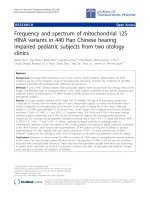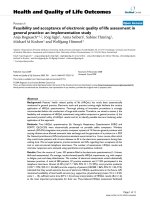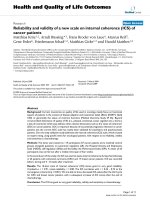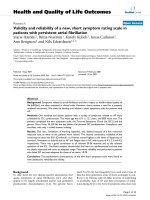Báo cáo hóa học: " Formation and Organization of Amino Terminated Self-assembled Layers on Si(001) Surface" docx
Bạn đang xem bản rút gọn của tài liệu. Xem và tải ngay bản đầy đủ của tài liệu tại đây (241.61 KB, 5 trang )
NANO EXPRESS
Formation and Organization of Amino Terminated
Self-assembled Layers on Si(001) Surface
G. Demirel Æ M. O. C¸ag
˘
layan Æ B. Garipcan Æ
M. Duman Æ E. Pis¸kin
Received: 14 May 2007 / Accepted: 11 June 2007 / Published online: 29 June 2007
Ó to the authors 2007
Abstract We have investigated the effects of dipping time,
solution concentration and solvent type on the formation of
self-assembled monolayers with aminosiloxane molecules
(i.e., N-(3 trimethoxysilylpropyl)diethylenetriamine (TPDA))
on the Si(001) surface. Studies performed with an ellips-
ometer showed that monolayers with a thickness of about
1.2 nm were formed when the dipping time is about 2 h,
while multilayer were observed for longer time periods. The
effect of the TPDA concentration on the thickness of the
deposited layer was not very profound, however, the contact
angle data exhibit importance of concentration on the surface
coverage. The type of the solvent used in the formation of the
monolayers was found an important parameter. Monolayers
were formed with solvent having larger dielectric constants.
Relatively thick multilayer was observed when benzene was
used as the solvent, due to its quite low dielectric constant
(hydrophobicity).
Keywords N-(3-Trimethoxysilylpropyl)
diethylenetriamine (TPDA) Á Hydroxylated silicon Á
Self-assembled monolayer Á Ellipsometry Á Si(001) surface
Introduction
Self-assembly has recently emerged as a new approach in
chemical synthesis, nanotechnology, polymer science,
materials science, and engineering. Molecular self-assem-
bly systems lie at the interface of these disciplines and
many self-assembling systems have been developed.
Self-assembled monolayers (SAMs) are a class of molec-
ular assemblies that are typically prepared by exposure of a
surface to molecules with chemical groups that possess
strong affinities for the substrate. The driving force for the
formation of the monolayer includes chemisorption of
functionalized molecules on the substrate surface, and the
intermolecular interactions. Due to their ease of prepara-
tion and controllable surface chemical functionality, SAMs
represent suitable model systems for studying wetting
[1–3], corrosion [4, 5], adhesion [6, 7], tribology [8–12],
charge transfer through molecules [13], and model surfaces
for biochemistry and cell biology [14]. Other applications
(resistance to etchants [15] and protein adsorption, modi-
fied electrodes for electrochemistry) rely on the ability of
SAMs to prevent diffusion of other molecules to the sur-
face of the underlying substrate [16].
The final morphology and thickness of a SAMs are
reported to be extremely sensitive to experimental param-
eters including the type of precursor molecule, concentra-
tion, type of solvent and its quality, temperature and
reaction time, etc. Despite several experimental investiga-
tions dedicated to the grafting of organic molecules to the
silicon surface, there are only few description of such
grafting and fewer attempts to understand the self-assembly
formation. In the present work, SAMs with amino end
group were prepared by using N-(3-trimethoxysilylpro-
pyl)diethylenetriamine (TPDA) molecule on the Si(001)
surface. Effects of dipping time, solution concentration and
solvent type on the formation of TPDA on Si(001) have
been investigated. Subsequently, thicknesses and water
contact angle of each film were measured using imaging
ellipsometry and contact angle goniometer, respectively.
G. Demirel (&) Á M. O. C¸ag
˘
layan Á B. Garipcan Á
M. Duman Á E. Pis¸kin
Department of Chemical Engineering and Division of
Bioengineering, Hacettepe University, Beytepe, Ankara 06800,
Turkey
e-mail:
123
Nanoscale Res Lett (2007) 2:350–354
DOI 10.1007/s11671-007-9071-7
Experimental
The substrates used in these experiments were Si(001)
wafers (n-type, obtained from Shin-etsu, Handoutai,
Japan). The substrates were cut into 5 · 5 mm pieces for
further modification. The substrates were first cleaned by
repeated rinsing with deionized water and ethanol. They
were then further cleaned a mixture of NH
3
(25%, v/v),
H
2
O
2
(30%, v/v), and deionized water having a volume
ratio of 1:1:5 at the temperature of 70 °C during 20 min.
Afterward, the substrates were washed with ethanol and
dried under nitrogen stream. Finally, these substrates
were exposed in UV/ozone chamber (Irvine, CA: Model
42, Jelight Company Inc. USA) for 15 min prior to
modification in order to remove hydrocarbon and to
produce a hydrophilic surface. For this cleaned surface,
the water contact angle was about 3°. The lower contact
angle obtained is consistent with the presence of in-
creased number of hydroxyl groups on the cleaned sur-
face [17].
Unless otherwise stated, freshly prepared TPDA (Al-
drich USA) solutions (0.25, 0.5, 1.0, 2.0, 4.0, and 8.0%, v/
v) in absolute ethanol (Aldrich USA) were used for the
monolayer formation. Silicon wafers were dipped in the
TPDA solution of particular concentrations and were re-
moved from solution after selected time intervals. Static
water contact angles of the sample surfaces were measured
at 25 °C in ambient air using an automatic contact angle
goniometer equipped with a flash camera (model DSA 100,
Kru
¨
ss, Germany) applying the sessile drop method. The
volume of the drop used was always 1 lL in all mea-
surements. The contact angles are calculated by using the
software of the instrument. All reported values herein are
the averages of at least nine measurements taken at three
different locations on each sample surface and have a
maximum deviation of ±1°. The vertical structures of the
samples, especially the (optical) thickness of layers were
also measured by means of an auto-nulling imaging
ellipsometer (Nanofilm EP3, Germany). All thickness
measurements have been performed at a wavelength of
532 nm with an angle of incidence of 72°. In the
layer thickness analysis, a four-zone auto-nulling proce-
dure integrating over a sample area of approximately
50 · 50 lm followed by a fitting algorithm has been per-
formed. In the analysis of the hydroxylated surface and the
SAMs formed on it, a four-phase model consisting of sil-
icon substrate/SiO
2
/overlayer/air is assumed. The designed
overlayers are assumed to be transparent; a generally rea-
sonable approximation for organic layers with C-chains
[18]. Since the thickness and refractive index are highly
correlated for very thin films (less than 10 nm), refractive
index of the overlayer can be reasonably assumed and then
thickness of the overlayer can be determined. Refractive
indices as 3.8650 for Si substrate, 1.4605 for the SiO
2
layer
and 1.4600 for the TPDA layer in the model have been
applied.
Results and Discussion
Effect of Dipping Time
We have firstly looked at the effect of dipping time on the
formation of TPDA molecules on the silicon surface.
Dipping time has been reported as one of the most
important criteria for the formation of alkoxysilane mole-
cules i.e., TPDA [19, 20]. The effect of dipping time on the
formation was investigated by using 1% (v/v) TPDA
solution in absolute ethanol within various time intervals
(0–24 h) at room temperature. The chances both in the
thickness and water contact angle of the Si(001) surface
due to attachment of TPDA molecules, with the dipping
time are given in Fig. 1. As seen here, the film thickness is
observed about 1.2 nm during the first 2 h. We also
calculated the theoretical molecular length of TPDA
molecule by VASP (Vienna Ab initio Simulation Package
(VASP)), and found as 1.39 nm. It seems that, in the first
2 h, the TPDA molecules are forming nice monolayer on
the silicon surface. However, increasing the dipping time
over 2 h, result significant increases in the thickness, which
may be explained by multilayer formation. Multilayer
formation may be discussed in two alternative or parallel
processes. In the first one, we can assume that, TPDA
molecules react rapidly with water in the solution to form
TPDA oligomers. However, complete polymerization in
two dimensions may not be possible due to the space
constraints imposed by the chain. When the oligomers
diffuse onto the substrate surface, they may be adsorbed
first by simple physical interaction, and then, they do react
Fig. 1 Effect of solution dipping time on the film thickness and water
contact angle
Nanoscale Res Lett (2007) 2:350–354 351
123
with the substrate surface groups chemically, i.e., by
elimination of water and formation of Si–O–Si bonds to the
substrate, as also mentioned in the related literature [21].
The alkyl chains of the oligomers may be closely packed in
order to minimize their energy via van der Waals interac-
tions on the substrate surface. The driving force for this
step is lateral interaction between oligomers (two-dimen-
sional condensation). Therefore, there will be residual
silanol (Si–OH) groups dangling from the two-dimensional
network, which result chemical bonding on the substrate
surface. These structures which are formed more than one
TPDA molecules (oligomeric structures) may be consid-
ered as multilayer (see Fig. 1). In a parallel second type of
process, the amino groups in the aminosilane molecules
(TPDA), i.e., –NH
2
and –NH–, may form a hydrogen or
ionic bond with a methoxysilane group or its hydrolysis
form, i.e., Si–O–CH
3
or Si–OH, respectively, in another
aminosilane molecule, or in other terms they do form the
two-dimensional network of the oligomers aggregates
which diffuse onto the substrate surface, do directly
interact with the functional groups of the substrate (in the
unoccupied areas) or via interaction with the TPDA mol-
ecules that are already formed monolayers, which is also an
important alternative pathway for the formation of multi-
layer on the silicon substrate surfaces [22–24]. Unfortu-
nately, with the experimental set ups in our study and also
used by others, it is not possible to exhibit the exact pro-
cesses for the formation of multilayer, or relative contri-
butions of the two alternative processes discussed above.
The contact angle of water is sensitive to the polarity of
the surface and may be used as an indication of hydro-
philicity. The change in the contact angle has been used to
describe roughly the variation in surface chemical com-
position of the substrate as well as the extent of the surface
coverage [25]. Figure 1 shows the variation of contact
angle of the hydroxylated Si(001) surfaces as a function of
dipping time in the TPDA solution, which were obtained in
this study by using a sessile water drop technique. A clean
Si surface has usually a contact angle less than 15–20°,
which indicates its hydrophilic nature. As seen in Fig. 1,
there was a steep increase in contact angle values when we
were interacted these hydrophilic surfaces with the TPDA
solution, due to hydrophobic chains of TPDA molecules
(or oligomeric forms discussed above). Longer dipping
times resulted higher contact angles, but a plateau value
was reached around a dipping time of 12 h, which, most
probably correspond full coverage of the substrate surface,
as also discussed in the related literature recently [25–27].
For example, in the case of 1% (v/v) TPDA solution, the
contact angle values are 33° and 52° for a dipping time of 1
and 3 h respectively, whereas the steady state value is
65 ° ± 2.1 (for a dipping time of 24 h) indicating the full
surface coverage of TPDA molecules. These data are in
good agreement with the contact angles measured for water
on amino-terminated layers reported in the literature,
which were in the range of 23–68° [17].
Figures 2a, b and c exhibit the ellipsometric 3-D images
of the surface morphologies of the hydroxylated Si(001),
and the two examples treated with TPDA for two different
dipping times of 2 and 24 h, respectively. The surface
images of the TPDA interacted ones (dipped in TPDA
solution for various time intervals) are considerably dif-
ferent from the original hydroxylated silicon surface. The
yellow color in Fig. 2b demonstrates, most probably the
TPDA monolayers covering a large part of the substrate
surface. The red regions may be the ones containing
already some TPDA but they are relatively much lower
percentages, therefore the average thicknesses measured
(see earlier discussions) are in the level of monolayer
coverage. However, for longer periods of dipping (24 h),
the substrate surface is almost fully covered, and with
multilayer (the red color) as seen in Fig. 2c, which is
correlated with the findings demonstrated in the previous
paragraphs.
Effect of TPDA Concentration
The effect of TPDA concentration on the film thicknesses
and water contact angles on the hydroxylated silicon sur-
face were studied by using different concentration of
TPDA solutions (0.25–8%, v/v) in absolute ethanol within
2 h at room temperature. As seen in Fig. 3, the film
thickness increases with the solution concentration, but not
significantly. The average thickness found with 0.5% of
TPDA solution was about 1.24 nm at, while it was in the
range of 1.64–1.71 nm reached with the TPDA solutions of
2–8%. It seems that all the surfaces obtained with different
TPDA concentrations covered only with monolayers. It
Fig. 2 Ellipsometric 3-D images (50 · 50 lm); (a) Hydroxylated
silicon surface, (b) TPDA-Si(001) after 2 h, and (c) TPDA-Si(001)
after 24 h
352 Nanoscale Res Lett (2007) 2:350–354
123
should be noted that the dipping time was constant (2 h) in
all treatments.
Figure 3 also shows, in contrast to changes in the
thickness, the variation of water contact angle of the Si(001)
surfaces as a function of the TPDA concentration after
treatment is quite significant. For example, in the cases of
0.5 and 2% TPDA concentrations, the contact angle values
were 33.2° and 37.1°, respectively, while the difference at
higher concentrations were not very significant and about
38 ° ± 0.4 (for a solution concentration of 8%). It seems
that a 2% TPDA concentration was enough to form a
monolayer covering the whole surface of the substrate in
2 h, which corresponds a contact angle value of 38°.
Effect of Solvent Type
Self-assembly is the process by which monomeric mole-
cules recognize each other in solution and form aggregates
of complexity ranging from dimers to the mesoscopic-size
structures. The intermolecular forces that make molecular
recognition possible are very often dependent on the sol-
vent. For instance, an assembly held together by hydrogen
bonds may not be stable in hydrogen bonding solvents such
as water and alcohols. On the other hand, complexes using
the hydrophobic effect as their driving force usually dis-
sociate in hydrophobic organic solvents [28]. In our study,
the self-assembly formation of TPDA molecules on the
hydroxylated silicon surface were investigated by four
different solvents: ethanol, acetone, THF and benzene. In
this group of studies, the TPDA concentration and dipping
period were constant, i.e., 1% (v/v), and 2 h, respectively,
and interactions were performed at room temperature.
Table 1 shows the thickness and water contact angles of
reached on the Si(001) surfaces treated with TPDA solu-
tions in four different solvents. Measured thicknesses of
films prepared in ethanol, acetone, THF and benzene were
observed to be 1.45, 1.90, 2.86, and 14.70 nm, respectively.
Water contact angle values for films prepared in these
solvent were also found as 37.4, 39.1, 41.2, and 57.7°,
respectively. Note that the thickness and contact angle
values were in parallel, and very close values were obtained
with the first three solvent, while the values for benzene
were quite different. These results may be attributed to
dielectric constants of these solvents. Ethanol, acetone,
THF, and benzene have dielectric constants of 24.3, 20.7,
7.52, and 2.28, respectively. In our case, comparatively
much higher thickness and contact angles reached with
benzene may be explained as follows: Solvents having a
dielectric constant much higher than 4 (as the first three
solvents in our case), tend to dissolve the hydrophilic head-
groups of the SAM forming molecules (in our case TPDA)
within the medium and allow the formation of SAM on the
hydroxylated silicon surfaces [29]. On the other hand,
solvents having a dielectric constant lower than 4, oppo-
sitely may force the TPDA molecules to form reversed
micelles or network structures in the solution therefore
reducing the concentration of the hydrophilic TPDA head
groups in the medium which prevents SAM formation.
Most probably larger structures are formed in benzene, due
to its rather low dielectric constant (or hydrophobicity) and
Fig. 3 Effect of TPDA concentration on the film thickness and water
contact angle
Table 1 Thicknesses and water contact angle values of TPDA on
Si(001) in the different solvent types
Solvent type Thickness (nm) Contact angle (°)
Ethanol 1.453 ± 0.015 37.4 ± 0.55
Acetone 1.898 ± 0.021 44.3 ± 0.71
THF 2.859 ± 0.014 41.2 ± 0.91
Benzene 14.698 ± 0.016 57.7 ± 0.35
Fig. 4 Ellipsometric 3-D images (50 · 50 lm); (a) TPDA-Si(001) in
THF, (b) TDTA-Si(001) in acetone, and (c) TPDA-Si(001) in
benzene
Nanoscale Res Lett (2007) 2:350–354 353
123
they accumulated on the substrate surfaces rather as
multilayer. The ellipsometric 3-D images given in Fig. 4
support these discussions. The images of the surfaces
obtained with THF and acetone (Fig. 4a and b) clearly
shows that the surfaces are not fully covered but seems that
they are monolayers. However, in the case of benzene, the
substrate surface is almost covered and with a multilayer.
Conclusion
Amino-terminated self-assembled monolayers are currently
used commonly in both industrial and research-oriented
applications. Unfortunately, there is no clear and accepted
explanation of the formation (neither the mechanisms nor
the conditions) of SAM and/or multilayer on substrate
surfaces. In this study, we have selected a well known
surface, an hydroxylated Si(001) and investigated forma-
tion of SAMs (and or multilayer) of again a widely used
precursor molecule, i.e., N-(3-trimethoxysilylpropyl) die-
thylenetriamine (TPDA) on these surfaces at different
conditions. The dipping time was first parameter investi-
gated in this study. Monolayers were formed in dipping
times shorter than 2 h, longer periods resulted multilayer.
In the experimental set up we were not able to analyze the
multilayer structures. It was not also possible to describe
the formation mechanisms. Two alternative pathways,
formation of oligomers and then adsorption and reorien-
tation (two-dimensional networking) on the surface is one
of the mechanisms that one can propose. The other one is
the formation of oligomers and their aggregates in the
solution and then their adsorption onto the substrate surface
as multilayer. Most probably, both mechanisms are
occurring, but which one is contributing more we do not
know, we are currently working on designing new exper-
imental strategies to explain this behavior. It was observed
that the precursor concentration within the dipping medium
does not effect the thickness of the layers, however the
changes in the contact angles with the solution concentra-
tion was significant and interestingly related to the surface
coverage of the substrate. The type of the solvent was
found an important parameter to control the monolayer
formation. It seems that compatibility of the precursor
molecules and solvent is important. If one selects the
correct solvent, monolayers (or multilayer) with desired
orientation can be reached, however this needs also further
studies, which are under-investigation in our group as the
extension of this study.
Acknowledgement Authors would like to thank Go
¨
kc¸en Birlik
Demirel for theoretical calculations. Go
¨
khan Demirel was sup-
ported as a post-doctoral fellow by TU
¨
B
_
ITAK. Prof. Erhan
Pis¸kin was supported by Turkish Academy of Sciences as a full
member.
References
1. G.M. Whitesides, P.E. Laibinis, Langmuir 6, 87 (1990)
2. R. Colorado, T.R. Lee, Langmuir 19, 3288 (2003)
3. J.E. Pemberton, Langmuir 19, 6422 (2003)
4. T.D. Burleigh, Y. Gu, G. Donahey, M. Vida, D.H. Waldeck,
Corrosion 57, 1066 (2001)
5. G.K. Jenning, T.H. Yong, J.C. Munro, P.E. Laibinis, J. Am.
Chem. Soc. 125, 2950 (2003)
6. J.E. Houston, H.I. Kim, Acc. Chem. Res. 35, 547 (2002)
7. V.F. Petrenko, S. Peng, Can. J. Phys. 81, 387 (2003)
8. H.S. Ahn, P.D. Cuong, S. Park, Y.W. Kim, J.C. Lim, Wear 255,
819 (2003)
9. M. Nakano, T. Ishida, T. Numata, Y. Ando, S. Sasaki, Jpn. J.
Appl. Phys. Part 1 42, 4734 (2003)
10. L. Qian, F. Tian, X. Xiao, Tribol. Lett. 15, 169 (2003)
11. I.H. Sung, J.C. Yang, D.E. Kim, B.S. Shin, Wear 255, 808 (2003)
12. X. Yang, S.S. Perry, Langmuir 19, 6135 (2003)
13. A. Salomon, D. Cahen, S. Lindsay, J. Tomfohr, V.B. Engelkes,
C.D. Frisbie, Adv. Mater. 15, 1881 (2003)
14. E. Ostuni, L. Yan, G.M. Whitesides, Colloids Surf. B 15, 3 (1999)
15. J.C. Love, D.B. Wolfe, M.L. Chabinyc, K.E. Paul, G.M. White-
sides, J. Am. Chem. Soc. 124, 1576 (2002)
16. J.C. Love, L.A. Estroff, J.K. Kriebel, R.G. Nuzzo, G.M. White-
sides, Chem. Rev. 105, 1103–1170 (2005)
17. G. Demirel, T. Caykara, B. Akaoglu, M. Cakmak, Surf. Sci.
Accepted, (2007)
18. D.E. Aspness, in ed. by E.D. Palik. Handbook of Optical Con-
stants of Solids, (Academic Pres, Orlando, 1985)
19. L. Tortech, Z. Mekhalif, J. Delhalle, F. Guittard, S. Geribaldi,
Thin Solid Films 491, 253 (2005)
20. T. Komeda, K. Namba, Y. Nishioka, Appl. Phys. Lett. 70, 3398
(1997)
21. G. Demirel, G. Birlik, M. C¸ akmak, T. C¸ aykara, S¸. Ellialtioglu,
Surf. Sci. (in press, 2007)
22. A. Hozumi, Y. Yokogawa, T. Kameyama, H. Sugimura, K.
Hayashi, H. Shirayama, O. Takai, J. Vac. Sci. Technol. A 19,
1812 (2001)
23. H. Sugimura, A. Hozumi, T. Kameyama, O. Takai, Surf. Inter-
face. Anal. 34, 550 (2002)
24. F. Zhang, M.P. Srinivasan, Langmuir 20, 2309 (2004)
25. S.A. Kulkarni, S.A. Mirji, A.B. Mandale, R.P. Gupta, K.P.
Vijayamohanan, Mater. Lett. 59, 3890 (2005)
26. N. Tillman, A. Ulman, J.S. Schildkraut, T.L. Penner, J. Am.
Chem. Soc. 111, 6136 (1998)
27. D.L. Angst, G.W. Simmons, Langmuir 7, 2236 (1991)
28. O.M. Martin, L. Yu, S. Mecozzi, Chem. Commun. 39, 4964
(2005)
29. H.Y. Nie, M.J. Walzak, N.S. McIntyre, J. Phys. Chem.B 110
,
21101 (2006)
354 Nanoscale Res Lett (2007) 2:350–354
123









